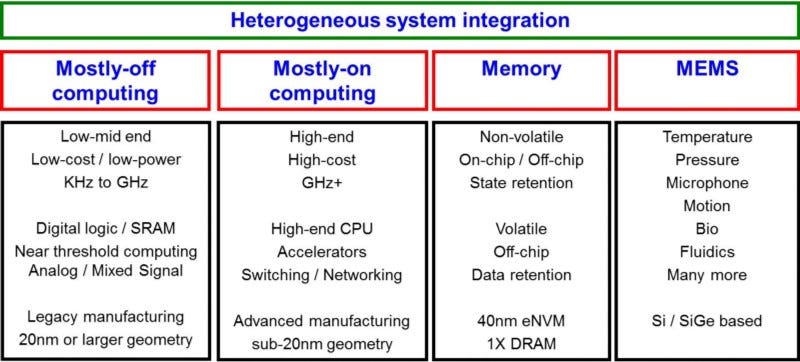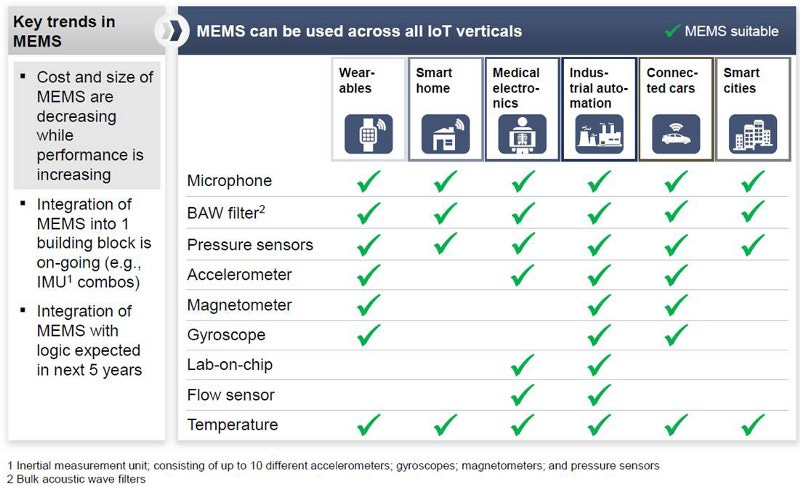How Will Silicon Platforms Evolve?
Semiconductor Technology for the Ubiquitous Computing Era
Every successive wave of computing has extracted more value from its enabling silicon platform while driving down the overall silicon contribution to the unit Bill of Materials (BoM). This trend will continue in the post-mobile, ubiquitous or pervasive era as “same-performance-for-less-cost” or “same-power-for-less-cost” become more important vectors than ever before.
During the PC era, silicon technology development was driven by a performance-centric roadmap. During the mobile era, the roadmap evolved to emphasize power constrained design. The silicon roadmap during the pervasive and ubiquitous computing era will be driven by overall power reduction, but with an added emphasis on cost and on chip- and package-level (SoC or SiP) integration
Five Vectors for Silicon Technology Development
The key functional areas that will drive the semiconductor industry forward are compute, connectivity, sensing and storage.
To enable progress in these functional areas, silicon transistor technology development is likely to coalesce around four main vectors. As the industry matures, there is likely to be major consolidation around these vectors. Some of the mergers announced in recent years can easily be categorized into one of these domains.

Mostly-Off Computing
The vast majority of “edge” computing applications will be powered by low-mid end silicon, designed for a highly constrained power envelope. The driving metric for technology development over time will be “energy-per-operation”. Digital logic, on-chip memory (SRAM), mixed signal computing (analog, IO, SERDES) will form some of the building blocks of this platform.
This platform will continue to be served by “legacy” manufacturing processes (e.g. 20nm node or larger geometry) and will utilize nearly fully depreciated manufacturing capacity worldwide, resulting in very low price-points for most of these chips (see: $5 computer by Raspberry Pi)
Mostly-On Computing
The datacenter will continue to push the frontiers of Moore’s Law and demand more performance-per-watt as a driving metric. These will typically be high-end, high performance computing parts (e.g. networking, switching, server CPU, high-end FPGA, high-end GPU, other accelerators). These applications will utilize advanced node manufacturing capacity (10nm or smaller nodes) and will continue to push for scaling in density, power and performance.
Memory
The industry is currently seeing resurgence in the development of new embedded non-volatile memory (e-NVM) solutions to succeed conventional silicon transistor based solutions like Flash technology. Embedded NVM will continue to be a big focus area until the industry settles on a new, scalable solution. Some candidates include Spin-torque based solutions (MRAM), resistive RAM solutions (R-RAM) and carbon nanotube based solutions (e.g. Nantero).
Intel’s recent announcement of a cross-point technology based Optane platform represents a breakthrough in developing storage-class-memory (SCM) and has the potential to change the contours of the data-center memory market. Optane appears to be part of Intel’s attempt to re-invent itself as a datacenter platform company (compute, storage and networking).
DRAM scaling, soon to commence the 1x scaling node will continue with novel breakthroughs like 3D stacking (Link).
MEMS
Micro-Electro-Mechanical Systems will form the fourth vector that will continue to grow within the semiconductor industry. MEMS has been the primary enabler behind many of the innovations in the smartphone and other wearable gadgets we use today. Simple actions that we now take for granted (e.g. landscape to portrait orientation change in iPad) and pedometers in smartphones are all enabled by MEMS sensors. Going forward, nearly all edge computing devices will contain at least one or more MEMS based sensors. A robust ecosystem has developed around MEMS technology led by players like Invensense, Bosch, STMicro, NXP among others.
While MEMS hardware will remain a critical piece of semiconductor devices, the technology is undergoing rapid commoditization and in terms of revenue dollars can be classified as a race to the bottom. As stated by the Invensense CEO Behrooz Abdi, the real money in MEMS is not in the hardware, but in the data (Link). Nevertheless, MEMS based sensor technology will continue advance and drive the IoT wave of computing.
Heterogeneous System Integration
Integrating two or more of the above four platforms will form the fifth vector for semiconductor technology development. A variety of packaging techniques will form the basis for this vector. The ability to integrate either on-chip or on-die a variety of functional accelerators will prove to be a competitive advantage for consumer electronics players like Apple (see my earlier essay, Computer on a Chip). In addition to consumer electronics manufacturers, system integration will also play an increasing role in bringing together disparate blocks like silicon based photonics for faster optical interconnects.

“More than Moore” is used to describe orthogonal scaling as opposed to geometrical scaling of Moore’s Law. For example, orthogonal scaling rejuvenates a legacy technology to reduce its total power envelope. Such innovation may also be extended to include enhanced on-chip functionality such as eNVM or enhanced system-level functionality via 2.5D scaling (interposers) or 3D scaling (through-silicon vias, or TSVs).
Judicious investment in these areas will enable foundries to capture a significant projected silicon volume migrating from 130 nm to sub-20 nm process nodes over the remainder of this decade. In the ultra-low cost, edge and sensor computing space, continued Moore’s Law scaling is likely to serve a limited number of applications and may not lead to high-volume design wins, at least in the near term. Whether very advanced transistor technologies (sub-10 nm) can offer the most effective integrated platforms necessary to succeed in the ultra-low cost space remains to be seen.
A holistic platform and system-level view suggests that cost, power, and highly disparate functional integration are the key technology metrics for success in the ubiquitous computing era.
If you liked this essay, please share it so that others may find it too.


